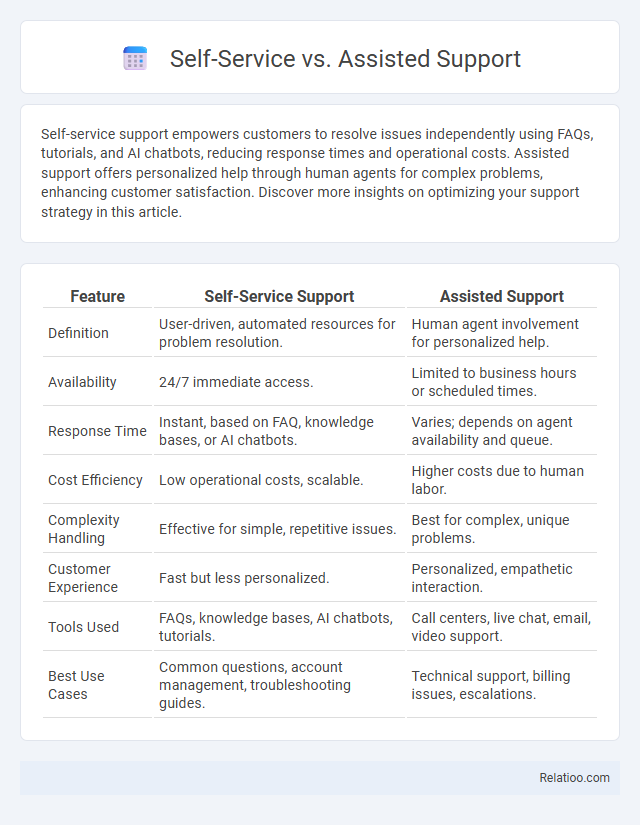Self-service support empowers customers to resolve issues independently using FAQs, tutorials, and AI chatbots, reducing response times and operational costs. Assisted support offers personalized help through human agents for complex problems, enhancing customer satisfaction. Discover more insights on optimizing your support strategy in this article.
Table of Comparison
| Feature | Self-Service Support | Assisted Support |
|---|---|---|
| Definition | User-driven, automated resources for problem resolution. | Human agent involvement for personalized help. |
| Availability | 24/7 immediate access. | Limited to business hours or scheduled times. |
| Response Time | Instant, based on FAQ, knowledge bases, or AI chatbots. | Varies; depends on agent availability and queue. |
| Cost Efficiency | Low operational costs, scalable. | Higher costs due to human labor. |
| Complexity Handling | Effective for simple, repetitive issues. | Best for complex, unique problems. |
| Customer Experience | Fast but less personalized. | Personalized, empathetic interaction. |
| Tools Used | FAQs, knowledge bases, AI chatbots, tutorials. | Call centers, live chat, email, video support. |
| Best Use Cases | Common questions, account management, troubleshooting guides. | Technical support, billing issues, escalations. |
Understanding Self-Service Support
Self-Service Support empowers users to resolve issues independently by leveraging resources such as knowledge bases, FAQs, and interactive tutorials, significantly reducing the need for direct human intervention. This model enhances customer satisfaction by providing 24/7 access to solutions, accelerating problem resolution, and lowering operational costs for businesses. Understanding Self-Service Support involves recognizing its role in optimizing user autonomy while complementing Assisted Support and traditional Support channels for a comprehensive customer service strategy.
What Is Assisted Support?
Assisted support refers to customer service where users receive direct help from support agents through chat, phone, or email, enhancing problem resolution efficiency compared to self-service options. Unlike self-service, which relies on knowledge bases or FAQs for users to solve issues independently, assisted support offers personalized guidance tailored to specific problems. This approach bridges the gap between automated solutions and full support services by combining efficiency with human expertise to improve customer satisfaction.
Key Differences Between Self-Service and Assisted Support
Self-service support allows users to find solutions independently via FAQs, knowledge bases, or automated chatbots. Assisted support involves direct interaction with customer service representatives who provide personalized help through phone, chat, or email. Key differences include response speed, user control, and the complexity of issues handled, with self-service suited for common problems and assisted support necessary for customized or complex queries.
Pros and Cons of Self-Service Support
Self-service support offers users quick access to information through FAQs, knowledge bases, and automated tools, significantly reducing wait times and operational costs while empowering customers with immediate solutions. However, it may fall short when addressing complex or unique issues requiring personalized assistance, potentially leading to frustration and unresolved problems. Self-service also relies heavily on well-maintained resources and user ability to navigate systems effectively, which can limit its effectiveness for less tech-savvy customers.
Advantages and Limitations of Assisted Support
Assisted support provides personalized help through live agents, offering tailored solutions and quicker resolution for complex issues that automated self-service can't handle. Its limitations include dependency on agent availability, potential wait times, and higher operational costs compared to self-service platforms. You benefit from human empathy and expertise, but it may not be as scalable or efficient for high-volume, straightforward inquiries.
When to Choose Self-Service Support
Self-service support is ideal when users seek quick resolutions for common issues through FAQs, knowledge bases, or automated chatbots, reducing wait times and operational costs. It excels in handling high volumes of routine queries without human intervention, improving efficiency and user satisfaction. Opt for self-service support when scalability and instant access to resources are priorities, and complex problem-solving or personalized assistance is unnecessary.
When Assisted Support Is Essential
Assisted support is essential when customer issues require personalized guidance or complex problem-solving beyond the capabilities of automated self-service tools. Situations involving technical troubleshooting, sensitive account information, or unique user scenarios demand human intervention to ensure accurate and empathetic resolution. Effective assisted support combines expert knowledge with real-time communication, enhancing customer satisfaction and loyalty.
Impact on Customer Satisfaction and Experience
Self-service options empower you to find quick solutions independently, enhancing convenience and reducing wait times, which significantly boosts customer satisfaction for straightforward issues. Assisted support delivers personalized help through human interaction, improving experience quality for complex problems and fostering trust and loyalty. Combining self-service with assisted support ensures a seamless customer journey, optimizing satisfaction by catering to diverse needs and preferences.
Cost Implications: Self-Service vs Assisted Support
Self-service support significantly reduces operational costs by minimizing the need for live agents, enabling businesses to handle a high volume of routine queries through automated tools such as FAQs, chatbots, and knowledge bases. Assisted support, while providing personalized and higher-quality interaction, incurs higher expenses due to salaries, training, and infrastructure for customer service representatives. Balancing self-service and assisted support optimizes cost-efficiency, ensuring basic inquiries are resolved cheaply while complex issues receive expert attention.
Future Trends in Customer Support Solutions
Future trends in customer support solutions highlight the integration of AI-powered self-service platforms that offer instant, 24/7 assistance through chatbots and knowledge bases, enhancing efficiency and reducing operational costs. Assisted support continues evolving with augmented reality and real-time video support, enabling agents to provide personalized, complex issue resolution remotely. Hybrid support models combining AI automation with human expertise drive seamless, scalable customer experiences, meeting growing expectations for speed, accuracy, and empathy in service delivery.

Infographic: Self-Service vs Assisted Support
 relatioo.com
relatioo.com